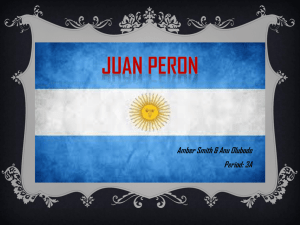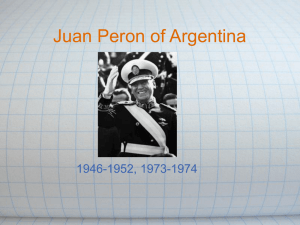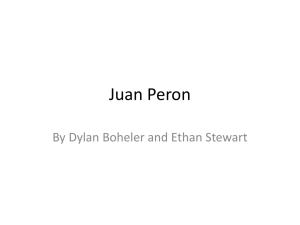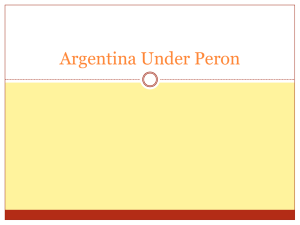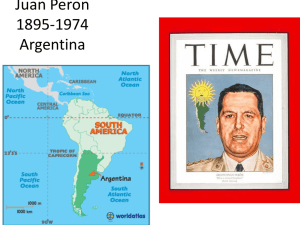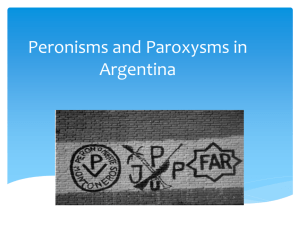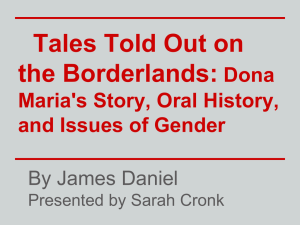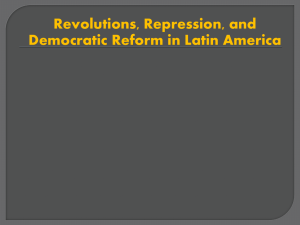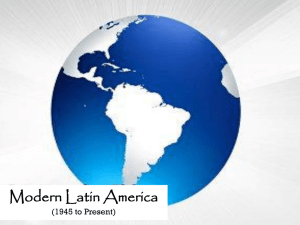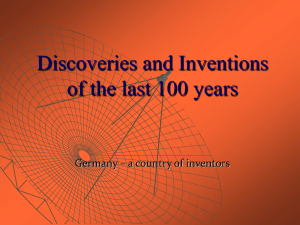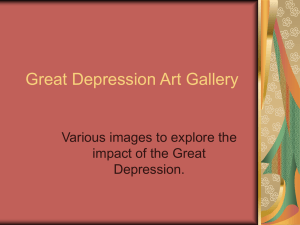Peron: Rise to power
advertisement
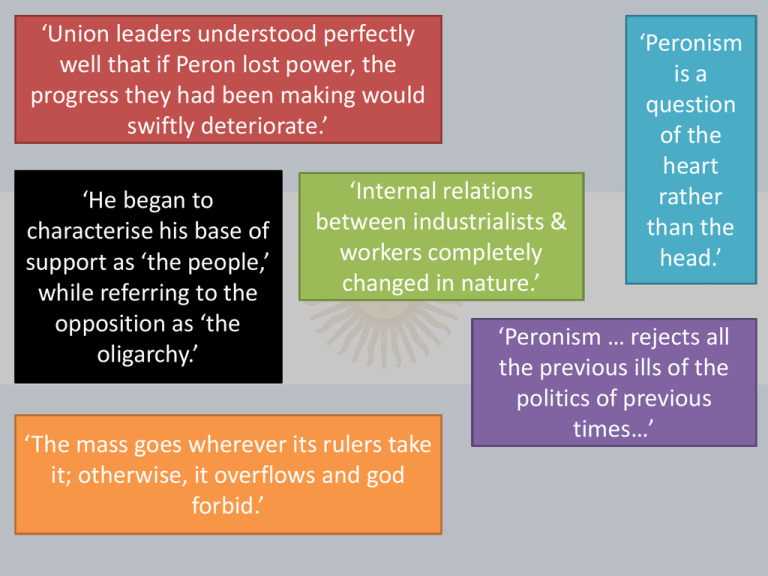
‘Union leaders understood perfectly well that if Peron lost power, the progress they had been making would swiftly deteriorate.’ ‘He began to characterise his base of support as ‘the people,’ while referring to the opposition as ‘the oligarchy.’ ‘Internal relations between industrialists & workers completely changed in nature.’ ‘The mass goes wherever its rulers take it; otherwise, it overflows and god forbid.’ ‘Peronism is a question of the heart rather than the head.’ ‘Peronism … rejects all the previous ills of the politics of previous times…’ Juan Peron’s Argentina Topic 3: Origin of Authoritarian and Single Party States Paper 2 Three periods to examine • Rise to power or emergence of SPS – what kind of circumstances made it possible? • Establishment of SPS – how is power maintained once power has been assumed? • Domestic policies & impact – how is the state structured & what kinds of policies (social & economic)? Role of women, attitudes to religion, culture inside the state? Hint: organise your notes under these headings Lesson 1a – Peron: Origin and Rise Essential Question Why did Peron come to Power? Learning Outcomes - Students will: – Learn what the Great Leap Forward was? – Learn about their consequences Success Criteria I can differentiate between the Shortterm and Long-term reasons why Peron came to power Reading • 10~28 • How is the rise of Peron similar and different to Hitler’s rise in Germany? Vocab • Infamous Decade Quick historical background • Independence from Spain 1816 • Economy in 19th & 20th century = export of food (wheat, meat) & import of manufactured goods • European immigrants = rural working class & skilled labourers continuous increase in agri output • Euro & US capital investments developed meatpacking, communications & service industries Buenos Aires = major port • Ruling class = landowners sustained growth until Great Depression How are the non-ruling class likely to feel about the ruling class? What do you think conditions for the non-ruling class are like? ‘The Infamous Decade’ 1930 - 1943 • Depression = difficulties importing goods that it didn’t produce • 1930 – econ difficulties = overthrow of ruling democratic party = start of Infamous Decade – Presidents came to power through coups or electoral fraud – Lots of econ & social changes – develop national industries, reduce dependency on imports – Traditional parties banned from elections, opponents persecuted, widespread corruption, no faith in system The international context What is going on in the world between 1930 and 1946? How would these events impact Argentina? Pick 1 & write a few sentences. Great Depression Fear / spread of communism Emergence of fascism The international context What is going on in the world between 1930 and 1946 as Peron is rising to power? Great Depression: difficulties importing goods which it didn’t produce – and it didn’t produce much that could be immediately consumed Fear / spread of communism: social & economic conditions could have attracted people to communism – as in Russia Emergence of fascism: Italy & Germany are fascist – people disillusioned with ‘democracy’ in infamous decade see improved conditions there What factors contributed to Peron’s rise to power? Create a chart and use pages 12-14 to fill it in. Long term factors Short term factors Do you think long term or short term factors contributed most to Peron’s rise to power? Pick at least one type of each factor to explain in more detail. Lesson 1b – Peron: Origin and Rise Essential Question Why did Peron come to Power? Learning Outcomes - Students will: – Review: Short-term and Long-term effects – Learn about their consequences Success Criteria I can explain why Peron rose to power What factors contributed to Peron’s rise to power? Create a chart and use pages 12-14 to fill it in. Long term factors Short term factors Corruption & ‘fake’ democracy Outbreak of WWII Middle class / intellectuals = no voice Military coup Working class disorganised / lacked a leader to address issues GOU & its programme Buenos Aires too influential & provinces suffered Vocab • • • • • Autarky Nationalization Protectionism 3 Peronist Principles descamisados Peron: Rise to power Complete the chart to help you keep track of the steps Peron took in his rise to power and what influenced his ideology (Peronism). You may work in a pair / group. Make sure that you can answer the question at the bottom of the page; the answer can be found in the book. 30 minutes Key terms – Peron’s economic goals Autarky: self sufficiency Nationalisation: when the state takes property previously owned by private individuals & companies Protectionism: Government policies promoting home industries by preventing the competition of foreign goods. Importation of goods is checked or discouraged by putting tariffs, quotas or regulations in place. Three Peronist Principles 1. Social justice – Wealth / privilege needs to be fairly distributed – State should be involved in this – No class struggle 2. Political sovereignty – State should represent all classes – State should be ‘above’ social classes 3. Economic independence – Nationalisation & autarky – Protectionism The Peronist economic reform had 2 main purposes. One was to preserve the country’s resources from the appetites of foreign interests and to put them at the service of the state. The other was to divide up those resources fairly so that there would be no excessively wealthy people at the expense of excessively poor ones. Policy directors did not speak of socialism, of course, but rather of the social reform of the capitalist system: the capitalist system would remain in place but it would be restricted by state management. From Monica Esti Rein, Politics and Education in Argentina, 19461962, 1998. (page 21) a) Why did Peron favour nationalisation? b) How does economic independence relate to social justice and political sovereignty? Who supported & opposed Peron? Supporters • Working class / native Argentinians • CGT (General Confederation of Labour – union) • Labour Party • Unions • Army Opposition • • • • Wealthy landowners / farmers Industrialists & businessmen Traditional political parties Uni lecturers, intellectuals, newspapers – afraid of Peron’s growing power • Traditional Catholics in armed forces Use your book to help you write a few keywords or ideas to summarise why each group supported or opposed Peron. You may work with a partner / split up the work. Pages 22-23. 17 October 1945 Read the description of the events on page 24, then discuss the following questions with a partner. 1. Who are the ‘descamisados’? 2. List a few characteristics of 17 October that made it stand out. 3. What is significant about the protest? 17 October 1945 1. Who are the ‘descamisados’? – ‘the shirtless’ – Peron’s followers / workers 2. List a few characteristics of 17 October that made it stand out. – Broke ‘dress code’; washed in the fountains; broke social codes; workers / powerless won 3. What is significant about the protest? – Workers secured Peron’s release TOK connection 1946 elections • Labour Party support, trade unions, radical parties • UD = opposition but lots of internal problems, including with US ambassador • Christmas bonus = more support for Peron, but why? • Wins by 55% of the vote What do you think? • What are the most significant factors that led to the rise of Peron? • Name 2 groups that opposed Peron and suggest why. • How important was Peron’s role as Secretary of Labour and Welfare?
